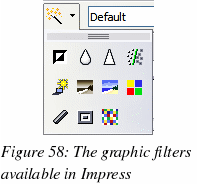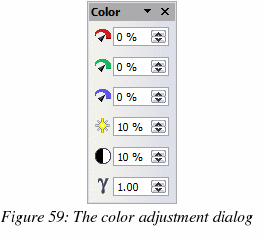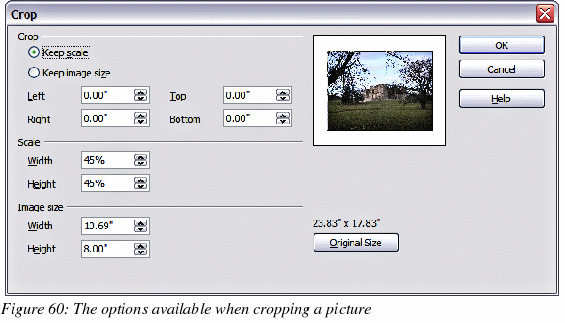Formatting pictures
This section
discusses the formatting of pictures inserted with one of the
methods explained in “Inserting pictures” on page 77.
Moving
a picture
Click
the picture, if necessary, to show the green resizing handles.
Move
the pointer over the picture until the pointer changes shape. On
most operating systems, the cursor associated with moving objects
is a four headed arrow, but it may also be a hand or some other
symbol.
Click
and drag the picture to the desired position.
Release
the mouse button.
For
a more accurate placement of the picture, use the Position and Size
dialog described in Chapter 6 (Formatting Graphic Objects).
Resizing
a picture
Click
the picture, if necessary, to show the green resizing handles.
Position
the pointer over one of the green resizing handles. The pointer
changes shape giving a graphical representation of the direction of
the resizing.
Click
and drag to resize the picture.
Release
the mouse button when satisfied with the new size.
The
corner handles resize both the width and the height of the graphic
object simultaneously, while the other four handles only resize one
dimension at a time.
|
Tip
|
To
retain the original proportions of the graphic, Shift+click
one of the corner handles, then drag. Be sure to release the
mouse button before
releasing the Shift
key.
|
For
more accurate resizing of the graphic object, use the Position and
Size dialog described in Chapter 6 (Formatting Graphic Objects).
|
Caution

|
Be
aware that re-sizing a bit-mapped (raster) image will adversely
affect the resolution, causing some degree of blurring. It is
better to externally size your picture before insertion into your
presentation, if possible.
|
Rotating
a picture
As for the position
and the size, rotation of a picture can be done manually or using a
dedicated dialog. The Rotation dialog is described in Chapter 6
(Formatting Graphic Objects). To rotate a picture manually, do as
follows:
Select
the picture if necessary so that the green handles around it show.
Click
the Rotate button
 on the Drawing toolbar. This toolbar is usually located at the
bottom the screen, but it can be undocked and used as a floating
toolbar. If the toolbar is not showing, select View
> Toolbars > Drawing. The Drawing toolbar is
discussed in detail in Chapter 5 (Creating Graphic Objects).
on the Drawing toolbar. This toolbar is usually located at the
bottom the screen, but it can be undocked and used as a floating
toolbar. If the toolbar is not showing, select View
> Toolbars > Drawing. The Drawing toolbar is
discussed in detail in Chapter 5 (Creating Graphic Objects).
|
Note
|
The
icons representing the functions in the toolbars are different,
depending on the operating system used and on whether OOo has
been customized for the Linux distribution in use or not. When
in doubt, hover the mouse over the icons and wait for the
tooltip to appear showing the name of the button.
|
Eight
red circular handles replace the green square handles, as shown in
Figure 56. Move the mouse over one of the corner handles and the
mouse cursor shape will change. Click the mouse and move in the
direction in which you want to rotate the picture.
When
satisfied, release the mouse button.

At
step 2 a black crosshair with a circle appears in the middle of the
picture: this represents the pivot point for the rotation. Normally
the center of the picture will be just fine, but on some occasions
you may wish to rotate around a corner or even around a point
outside the picture; to do that, click on the crosshair and drag it
to the desired position before applying the rotation, as shown in Figure 56.
To
restrict the rotation angles to multiples of 15 degrees, press the
Shift
key while rotating the graphic. This is very handy to rotate
pictures of right angles, for example from portrait to landscape or
vice versa.
Formatting
using the Picture toolbar
When
a picture is selected, the Picture toolbar (Figure 57) becomes
available. This toolbar provides a number of formatting options
which are described in this section. If the picture toolbar does not
show when an image is selected, display it by selecting View
> Toolbars > Picture from the menu bar.

Applying
filters
Use
the left-most icon on the toolbar to apply various filters to the
selected picture. The best way to judge if a filter works for your
picture is to try it (step 4 of the following procedure explains how
to undo). To apply a filter:
Select
the image so that the green handles around it show.
Click
on the magic wand icon
 in the Picture toolbar. The toolbar will expand to show the icons
in Figure 58.
in the Picture toolbar. The toolbar will expand to show the icons
in Figure 58.

Select
the filter to apply. To show the name of the filter, hover the
mouse pointer over the icon and wait for the tooltip to appear.
If
not satisfied with the effect obtained, before doing anything else
click the Undo button or select Edit
> Undo: Bitmap Graphic Filter from the menu bar or
press Control+Z.
Table 1 describes
briefly each of the available graphic filters and their effects. See
the Draw
Guide for examples of the effects.
Table
1: Graphic filters and their effects
-
|
Icon
|
Name
|
Effect
|
|

|
Invert
|
Inverts
the color values of a color image, or the brightness values of
a grayscale image.
|
|

|
Smooth
|
Softens
the contrast of an image.
|
|

|
Sharpen
|
Increases
the contrast of an image.
|
|

|
Remove
noise
|
Removes
single pixels from an image.
|
|

|
Solarization
|
Mimics
the effects of too much light in a picture. A further dialog
opens to adjust the parameters.
|
|

|
Aging
|
Simulates
the effects of time on a picture. Can be applied several times.
A further dialog will open to adjust the aging level.
|
|

|
Posterize
|
Makes
a picture appear like a painting by reducing the number of
colors used.
|
|

|
Pop
Art
|
Modifies
the picture dramatically.
|
|

|
Charcoal
|
Displays
the image as a charcoal sketch.
|
|

|
Relief
|
A
dialog is displayed to adjust the light source that on turn
will create the shadow and hence the relief effect.
|
|

|
Mosaic
|
Joins
groups of pixels into a single area of one color.
|
Changing
the Graphics mode
Use the next box in
the Picture toolbar to change the mode of the image. Choose between:
Default:
no changes to the graphic object.
Grayscale:
the image is converted to scales of gray.
Black/White:
each pixel of the image is converted to black or white depending on
the brightness value.
Watermark:
adjusts the brightness of the image making it suitable to be used
as a watermark. For more information on creating watermarks, refer
to Chapter 2.
Adjusting
the color
Clicking
the color adjustment button
 on the Picture toolbar opens the color adjustment dialog, shown in
Figure 59.
on the Picture toolbar opens the color adjustment dialog, shown in
Figure 59.
Use
this dialog to modify the individual color components of the image
(red, green, blue) as well as the brightness, contrast, and gamma of
the image. If the result is not satisfactory, press Control+Z
to restore the default values.

Setting
the object transparency
Modify
the percentage value in the Transparency box
 on the Picture toolbar to make the image more transparent. Note that
this is different from the transparency settings for a line or a
shape (described in Chapter 5).
on the Picture toolbar to make the image more transparent. Note that
this is different from the transparency settings for a line or a
shape (described in Chapter 5).
Adjusting
the line, area and shadow settings
These
settings are not very commonly used for images, with the exception
of the shadow setting that applies a shadow to the image.
Cropping
pictures
To
start cropping a picture, select the Crop icon
 on the Picture toolbar (Figure 57).
on the Picture toolbar (Figure 57).

The Crop dialog (Figure 60)
has the following options:
Keep
scale / Keep
image size buttons: when Keep
scale is selected (default), cropping the image
does not alter the scale of the picture.
When Keep
image size is selected, cropping produce
enlargement (for positive cropping values), shrinking (for negative
cropping values), or distortion of the image so that the image size
remains constant.
Left,
Right, Top,
and Bottom: the
function of these boxes changes according to the choice made
between Keep
scale and Keep
image size. In both cases, when a value is
entered in one of these boxes, the image is cropped by that amount.
For example, a value of 3cm in the Left box will cut 3cm from the
left side of the picture.
When
Keep
scale is selected, the size of the image also
changes, so in this example the width will be reduced by 3 cm. If
Keep
image size is selected instead, the remaining
part of the image is enlarged (positive values for cropping) or
shrunk (negative values for cropping) so that the width and height
of the image remains unchanged.
Note
that the Width
and Height
fields change as you enter the values when in this mode. Use the
thumbnail next to these fields to determine the correct amount by
which to crop.
Scale
Width and Height:
specify in percentages the scaling of the picture.
The size of the image changes accordingly.
Image
size: specify the size of the image in your preferred
unit of measurement. The image enlarges or shrinks accordingly.
Original
size: when clicked, restores the original image size.
Deleting
a picture
Click
on the picture, if necessary, to show the green resizing handles.
Press
Delete.
